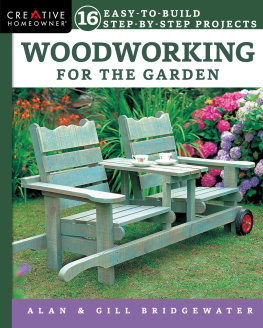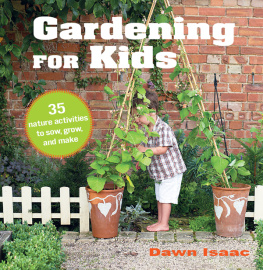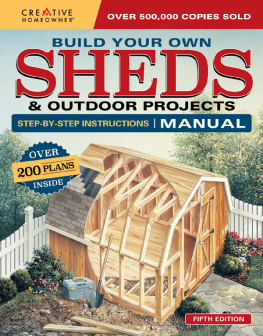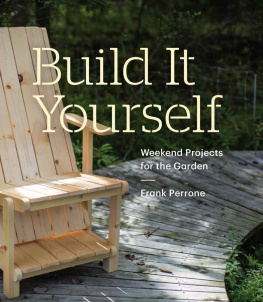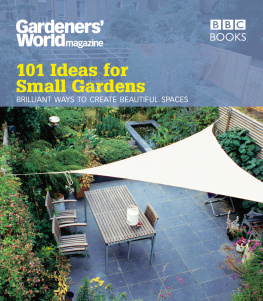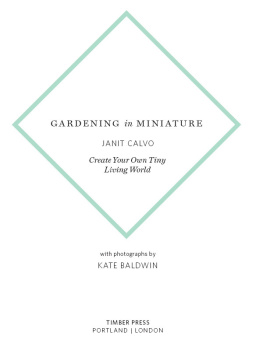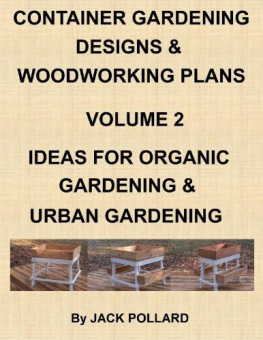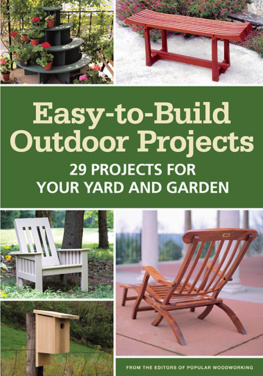Beautiful
Wooden Project
for Outdoor Living
JOHN MARCKWORTH


Beautiful Wooden Projects for Outdoor Living. Copyright 2006 by John Marckworth. Printed and bound in China. All rights reserved. No part of this book may be reproduced in any form or by any electronic or mechanical means including information storage and retrieval systems without permission in writing from the publisher, except by a reviewer, who may quote brief passages in a review. Published by Popular Woodworking Books, an imprint of F+W Publications, Inc., 4700 East Galbraith Road, Cincinnati, Ohio, 45236. First edition.
Distributed in Canada by Fraser Direct
100 Armstrong Avenue
Georgetown, Ontario L7G 5S4
Canada
Distributed in the U.K. and Europe by David & Charles
Brunel House
Newton Abbot
Devon TQ12 4PU
England
Tel: (+44) 1626 323200
Fax: (+44) 1626 323319
E-mail: mail@davidandcharles.co.uk
Distributed in Australia by Capricorn Link
P.O. Box 704
Windsor, NSW 2756
Australia
Visit our Web site at www.popularwoodworking.com for information on more resources for woodworkers.
Other fine Popular Woodworking Books are available from your local bookstore or direct from the publisher.
10 09 08 07 5 4 3 2
Library of Congress Cataloging-in-Publication Data
Marckworth, John.
Beautiful wooden projects for outdoor living/John Marckworth.
p. cm.
Includes index.
ISBN-13: 978-1-55870-772-6 (pbk.: alk. paper)
eISBN-13: 978-1-4403-1638-8
ISBN-10: 1-55870-772-7 (pbk.: alk. paper)
1. Outdoor furniture Design and construction. 2. Garden ornaments and furniture Design and construction. 3. Woodwork. I. Title.
TT197.5.O9M36 2006
684.1'8 dc22
2006008276
ACQUISITIONS EDITOR: Jim Stack
EDITOR: Amy Hattersley
DESIGNER: Brian Roeth
ILLUSTRATOR: Len Churchill
PRODUCTION COORDINATOR: Jennifer L. Wagner
PROJECT OPENER PHOTOGRAPHER: Craig Wester
STEP-BY-STEP PHOTOGRAPHER: John Marckworth

Metric Conversion Chart
to convert | to | multiply by |
Inches | Centimeters | 2.54 |
Centimeters | Inches | 0.39 |
Feet | Centimeters | 30.5 |
Centimeters | Feet | 0.03 |
Yards | Meters | 0.91 |
Meters | Yards | 1.09 |
Read This Important Safety Notice
To prevent accidents, keep safety in mind while you work. Use the safety guards installed on power equipment; they are for your protection. When working on power equipment, keep fingers away from saw blades, wear safety goggles to prevent injuries from flying wood chips and sawdust, wear hearing protectors, and consider installing a dust vacuum to reduce the amount of airborne sawdust in your woodshop. Don't wear loose clothing, such as neckties or shirts with loose sleeves, or jewelry, such as rings, necklaces or bracelets, when working on power equipment. Tie back long hair to prevent it from getting caught in your equipment. People who are sensitive to certain chemicals should check the chemical content of any product before using it. The authors and editors who compiled this book have tried to make the contents as accurate and correct as possible. Plans, illustrations, photographs and text have been carefully checked. All instructions, plans and projects should be carefully read, studied and understood before beginning construction. Due to the variability of local conditions, construction materials, skill levels, etc., neither the author nor Popular Woodworking Books assumes any responsibility for any accidents, injuries, damages or other losses incurred resulting from the material presented in this book. Prices listed for supplies and equipment were current at the time of publication and are subject to change. Glass shelving should have all edges polished and must be tempered. Untempered glass shelves may shatter and can cause serious bodily injury. Tempered shelves are very strong and if they break will just crumble, minimizing personal injury.
(dedication)
To Phyllis, my tour guide into the world of the garden. You point and I'll dig!
About the Author
John Marckworth has worked as a carpenter and cabinetmaker for the last twenty-five years. He owns and operates Marckworth Specialty Woodworking in Port Townsend, WA. His business card reads, Furniture, Custom Cabinetry, Fine Finish Carpentry and Interesting Projects and he enjoys them all.
John, his wife Phyllis and their daughter Kate are also avid gardeners and have spent many years turning a back yard full of six-foot-tall blackberry bushes into the garden for which the projects in this book were designed.
He plans additional garden projects in the future and may even get around to mowing the lawn.
Acknowledgements
My heartfelt thanks to all who helped make this book possible:
To Phyllis, who is still patiently waiting for me to finish the kitchen remodel.
To Kate, who grew up with the whine of the tablesaw in the background, insisting that it really didn't bother her
To Bob Schwiesow and Anne Hirondelle, who showed me that new careers are possible and that remodeling can be fun.
To Jim Tolpin author, woodworker and friend who recruited me into the world of writing about woodworking.
To Craig Wester photographer extrodinaire.
To all the woodworkerss who have so generously shared their knowledge and tips over the years.
And finally,
To Jim Stack and Amy Hattersley my editors at Popular Woodworking Books who have led (not to say herded) me through the process with good humor, help and support. And to the rest of the staff at F+W Publications.
Len Churchill your artwork is the best.
( table of contents )

introduction

Gardens and gardening mean different things to different people. For some they're an exercise in harmony with gentle nature, working with indigenous plantings and fostering supportive habitats for native birds, insects and wildlife. For others they become a test of will and technology versus nature untamed the besieged human species struggling valiantly to bring order and discipline to the forces of anarchy and chaos. One garden might have beds and planting areas that seem to be scattered randomly across the landscape, while in another they are laid out with laser-like, geometric precision.
I admit to at least a nodding acquaintance with both philosophies. As a cabinetmaker, I subscribe to the ideals of careful layout, precise measurement and accurate execution; but I can also appreciate soft lines, meandering borders and the occasional item that seems to make absolutely no sense the first time you look at it. In our own garden, my wife and I have tried to utilize both approaches. Some areas we have planned with some formality, while some we have consciously left a bit wild and unruly. Also, being a woodworker, the planning occasionally drifted in a direction that just might involve a bit of carpentry.


